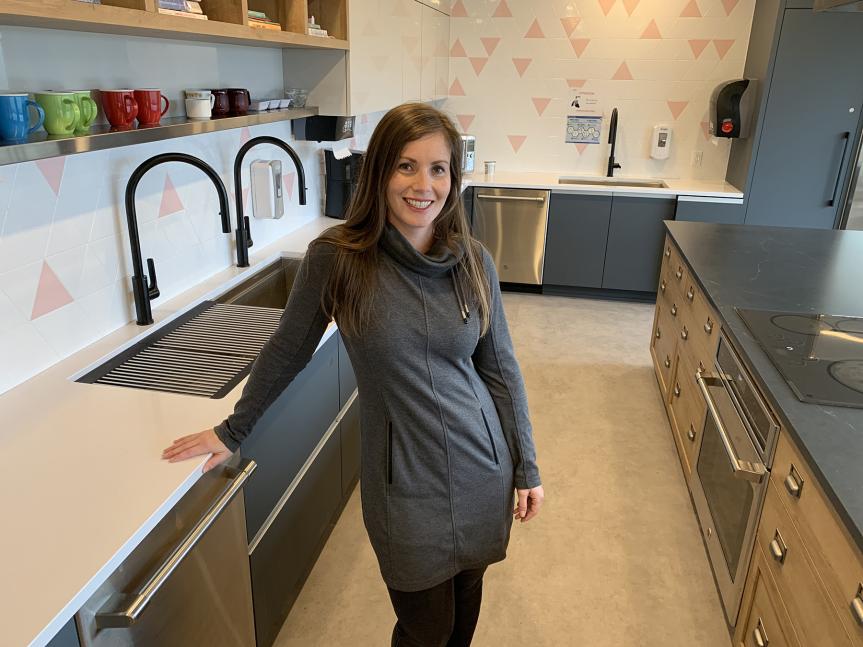This summer marks the 10th anniversary of the Recovery Program at The Royal, and it happens to coincide with a movement in mental health care towards recovery-oriented care and services.
The Recovery Program is for people who have a primary psychotic disorder or significant experience with psychosis.
“The Recovery Program launched within a framework of a much larger movement within mental health, which hadn’t really existed in this city before,” explains Dr. Alexandra Baines, a psychiatrist and clinical lead of the program. “This program allows us to provide support and services to people in ways we would not be able to otherwise, in ways that we view as really essential for some of the disorders that we work with.”
The traditional mental health care model was a top-down approach, largely focused on eradication of symptoms and reducing risk. In contrast, the recovery model is client-centred and considers people to be experts in their own care and is builds upon strength and hope.
“I’m privileged that I get to see people’s history and I get to hold their journey as part of where they are right now. And when you see how far people have come and what they’re struggling with – what they’re able to accomplish – it’s just awe-inspiring.” – Amanda Wannamaker, an occupational therapist in the Recovery Program
“Whether it’s returning to school, or volunteering, or work, or maintaining an improved self-care or activity level on a daily basis, we work with people who are trying to either improve independent living skills or re-engage in meaningful activities in their life,” says Baines, who started at the Recovery Program about a year after its launch.
Some clients might have challenges related to executive function, which Baines describes as a catch-all term for mental processes such as organizing, planning, initiation, and judgement.
“We use executive function for very basic things that we take for granted, like getting up at a certain time, getting a shower, getting dressed, having breakfast, getting out the door on time,” she says.
Sometimes the team has to get creative about presenting information to clients in a different way so it’s easier to remember. Baines gives an example of someone who couldn’t recall verbal directions to fry an egg, but when the instructions were written down using text and pictures, it finally clicked.
One of the biggest differences between receiving treatment in an acute care setting and the Recovery Program, is time.
“The real opportunity that we have at the Recovery Program is that we have time to get to know somebody, get to know their strengths and their needs, and come up with a tailored treatment plan – including their input – that might help move them forward in some functional goals.”
Clients work with a diverse team which includes nurses, occupational therapists, recreation therapists, social workers, a dietician, and peer specialists. Together, they provide individualized support to each client.
“Every person is so unique and we get to work on their unique goals with them,” says Amanda Wannamaker, an occupational therapist in the Recovery Program.
Client-centred, to meet client goals
The Recovery Program has evolved over the past decade, and one of the major drivers of that change comes from the clients themselves.
“We change as needs change,” says Wannamaker, who’s been with the program since its earliest days. Wannamaker gives the example of a long-running group program called Homeward Bound, which is designed to help people build skills so they can live more independently. When clients bring up new challenges they’re facing, the solutions become part of the “curriculum” for future groups.
Another significant change in the last decade has been the introduction of the Illness Management Recovery Program (IMR), a curriculum-based rehabilitation program that’s used with people who have mental health disorders. “It makes sure clients have a foundational knowledge of mental health, advocacy, and symptoms,” says Wannamaker. It helps clients connect to what they’re experiencing and what their peers are going through as well.
“I’ve learned a lot these last ten years, and what I’ve learned is that people are stronger than we ever thought possible, and I get to see that every day,” says Wannamaker. “I’m privileged that I get to see people’s history and I get to hold their journey as part of where they are right now. And when you see how far people have come and what they’re struggling with – what they’re able to accomplish – it’s just awe-inspiring.”
Kevin Patrick, who was in the Recovery Program for 14 months two years ago, says he was helped in many important ways, like with housing. Finding safe and affordable housing is a major challenge for many people whose lives are impacted by mental illness. Finding a new place for Patrick to live was an eight-month process, helped along by Jillian Crabbe, a social worker at The Royal.
“I have got the best home in the entire world. It’s a home, for the first time,” says Patrick. “For the last 12 years before recovery, I lived in a person’s basement. It never felt like a home.”
Patrick describes his new home as a “platform for other beautiful things,” such as volunteering. Today, he’s an active member of the Client Advisory Council at The Royal. Volunteering has lead to friendships, many of which are still going strong. He also enjoys baking bread, which was introduced to him by a nurse in the program. (You can read more about his bread making – and get his recipe – right here.)
“I’m having the best year I’ve ever had in the last 15 years. Everything points back to when I was in the Recovery Program,” he says. “It really builds from that. That’s how I got to Ancoura – where I have a home now. That’s where I got to volunteering, that’s where all of my friendships came from. So those things happened all because of the Recovery Program.”

